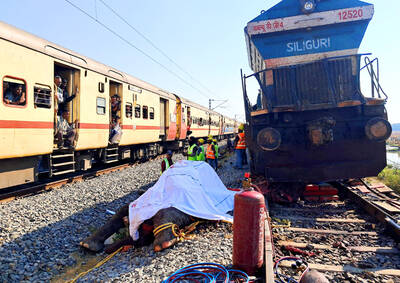The world's biggest bang wiped out the dinosaurs in a cataclysm that swathed our planet in choking dust -- or at least that is what many paleontologists claim. Others say dinosaurs died out gradually as Earth's climate and geology changed.
It sounds a typical academic dispute -- but last week it erupted into open warfare. Allegations have been made of deceit and unethical behavior. One scientist is even alleged to have held back inconvenient evidence.
"This affair has become an object lesson on how partisan and unethical the whole dinosaur controversy has become," said Norman MacLeod, keeper of paleontology at London's Natural History Museum.
"Young scientists are now refusing to get involved in this field because no matter what they say it will offend someone and damage their careers. It's like the nature-nurture debate. No matter what you say, someone will hate you for it."
The furore focuses on a massive drilling project set up to study the Chicxulub crater in Yucatan. Buried under half a mile of rock, the crater was created 65 million years ago when Earth was hit by a meteorite 16km in diameter. The blast would have blotted out the sun for decades, or even centuries, many researchers claim. Given that around this time the dinosaurs became extinct, many scientists made a direct link. Denied sunlight and food, most of the world's animals would have starved, and choked, to death.
But others disagree. Volcanoes, global warming or sea level changes were responsible, they say -- pointing to evidence that most dinosaurs became extinct before the explosion and to the fact that many large animals such as alligators survived this alleged catastrophe. Things weren't that bad, they say.
In a bid to resolve the dispute, a US$3 million project was launched in Yucatan two years ago. Researchers drilled a pipe into the Earth's crust to bring back samples of the meteor and crater wall. By studying what happened just before and just after the meteorite impact, scientists would glean critical insights, it was argued. For example, it would show if all life was extinguished in the millennia that followed the impact.
In 2002 the first samples were brought up. To the disgust of Mexican geologists, and to many scientists who doubted the Big Blast theory, these were entrusted to Jan Smit, a geologist at the Free University of Amsterdam and a leading supporter of the meteorite hypothesis. Promising to cut up the samples and distribute them to project scientists, Smit left with the precious Chicxulub remains. A year later, many scientists were still seeking the promised samples.
"We were dismayed," geochemist Erika Elswick of Indiana University in Bloomington states in the current issue of Nature. "There was no explanation given, no apology."
Eventually some samples were sent out, but most were too small for experiments. Dismay turned to fury. Researcher Gerta Keller, of Princeton University, pressed Smit and at last got a good set of samples. At the European Union of Geosciences conference in Nice, she presented her results, which were a bombshell.
Her research, Keller claimed, clearly showed that marine plankton, far from being killed off by debris blotting out the sun, thrived for hundreds of thousands of years after the crater was created. The meteor that struck at Chicxulub was not responsible for mass extinctions, she concluded.
Nor is Keller reticent in her interpretation of Smit's behavior.
"He tried to postpone our results so that he could remain unchallenged at that meeting," she states in Nature.
Smit dismisses the allegation as "ridiculous." He blames the delays on his busy schedule and poor communications by those running the project. He also claims Keller misidentified some fossils in her samples.
The row is far from over. Project scientists are preparing papers containing results of studies of the samples they obtained from Smit and these will be published in a special issue of Meteoritics and Planetary Science next year. Few doubt it will resolve the issue. As MacLeod says: "It's no longer about science. It's about reputations."

REVENGE: Trump said he had the support of the Syrian government for the strikes, which took place in response to an Islamic State attack on US soldiers last week The US launched large-scale airstrikes on more than 70 targets across Syria, the Pentagon said on Friday, fulfilling US President Donald Trump’s vow to strike back after the killing of two US soldiers. “This is not the beginning of a war — it is a declaration of vengeance,” US Secretary of Defense Pete Hegseth wrote on social media. “Today, we hunted and we killed our enemies. Lots of them. And we will continue.” The US Central Command said that fighter jets, attack helicopters and artillery targeted ISIS infrastructure and weapon sites. “All terrorists who are evil enough to attack Americans are hereby warned

‘POLITICAL LOYALTY’: The move breaks with decades of precedent among US administrations, which have tended to leave career ambassadors in their posts US President Donald Trump’s administration has ordered dozens of US ambassadors to step down, people familiar with the matter said, a precedent-breaking recall that would leave embassies abroad without US Senate-confirmed leadership. The envoys, career diplomats who were almost all named to their jobs under former US president Joe Biden, were told over the phone in the past few days they needed to depart in the next few weeks, the people said. They would not be fired, but finding new roles would be a challenge given that many are far along in their careers and opportunities for senior diplomats can

Seven wild Asiatic elephants were killed and a calf was injured when a high-speed passenger train collided with a herd crossing the tracks in India’s northeastern state of Assam early yesterday, local authorities said. The train driver spotted the herd of about 100 elephants and used the emergency brakes, but the train still hit some of the animals, Indian Railways spokesman Kapinjal Kishore Sharma told reporters. Five train coaches and the engine derailed following the impact, but there were no human casualties, Sharma said. Veterinarians carried out autopsies on the dead elephants, which were to be buried later in the day. The accident site

RUSHED: The US pushed for the October deal to be ready for a ceremony with Trump, but sometimes it takes time to create an agreement that can hold, a Thai official said Defense officials from Thailand and Cambodia are to meet tomorrow to discuss the possibility of resuming a ceasefire between the two countries, Thailand’s top diplomat said yesterday, as border fighting entered a third week. A ceasefire agreement in October was rushed to ensure it could be witnessed by US President Donald Trump and lacked sufficient details to ensure the deal to end the armed conflict would hold, Thai Minister of Foreign Affairs Sihasak Phuangketkeow said after an ASEAN foreign ministers’ meeting in Kuala Lumpur. The two countries agreed to hold talks using their General Border Committee, an established bilateral mechanism, with Thailand